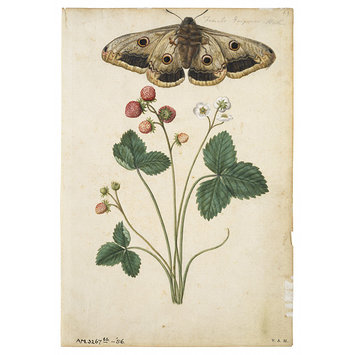 |
| Watercolor of Strawberries and Emperor Moth by Le Moyne |
I'm taking a break to celebrate my twins' 6th birthday, so not much of anything got done today. I did run across another book to add to my 16th century embroidery book obsession though. Most of the modelbuch don't really have more than a page or two of the animals and plants that we so often find in the extant pieces of embroideries. The animals, plants, and other pictorial scenes seem to come from other sources. It was actually the other sources that lead me to the modelbuch in the first place.
I got sucked into my fascination with the origins of 16th century patterns by reading Margaret Swain's The Needlework of Mary Queen of Scots and then Michael Bath's Emblems for a Queen, the Needlework of Mary Queen of Scots. Many of the animals came from natural history illustrations. I got Gessner's Historiae Animalium and spent a great deal of time investigating the various emblem books that are part of the English Emblem Book Project. All of these are used as sources for embroidered pieces. The book I ran across earlier this week seems to fill in a bit of the hole between these books published for other purposes and the ones published for embroidery. It is Jacques le Moyne's La Clef des Champs (The Key to the Meadow.) Published in 1586 in Blackfriar's in London. It is full of woodcuts of animals, flowers, and fruits, set out specifically for use as a pattern book. That makes it a bit different than Gessner and the emblem books since they were used and not intended for that specific purpose. Le Moyne specifically published his as a pattern book. The dedication to his patron,Lady Mary Sidney, puts forward the book to be of use to artists and craftspeople including goldsmiths, embroiderers, and tapestry makers.
 |
| Via |
 |
| Via |
Le Moyne himself was an interesting person and has become a much more well known and important artist in the 20th Century as some of his watercolors were discovered in the 1960's. He was a French Huguenot. He was the cartographer sent by the Charles IX of France as part of an expedition to Florida in 1564-65. The drawings he made were burned during a Spanish attack of Fort Caroline and he redrew many from memory later. They include some of the first depictions of Florida Natives giving him a place in history for that. It is the beauty and detail of the watercolors that really give him his importance, however. He is one of the earliest and best botanical artists of the Sixteenth century. If you want revel in the delicacy and beauty of some of his watercolor, search Jacques Le Moyne at the Victoria and Albert Museum. The same search at the British Museum will turn up the woodcuts for La Clef des Champs as well as many of the woodcuts of the French expedition in Florida. I certainly enjoyed both.
No comments:
Post a Comment